Asia's Healthcare System: China vs. USA Comparison Report
VerifiedAdded on 2021/06/15
|6
|1416
|149
Report
AI Summary
This report provides an overview of China's healthcare system, examining its structure, governance, and key features. It explores the system's evolution, emphasizing the shift from a centralized to a decentralized model and the role of government in regulating and financing healthcare. The report compares China's healthcare system with the United States, highlighting similarities and differences in funding, regulation, and expenditure. It also analyzes the advantages and disadvantages of China's system, including the decentralization benefits, recognition of traditional medicine, and the impact of government policies and insurance. The report concludes by summarizing the key findings and emphasizing the system's unique characteristics and implications for healthcare in the region.
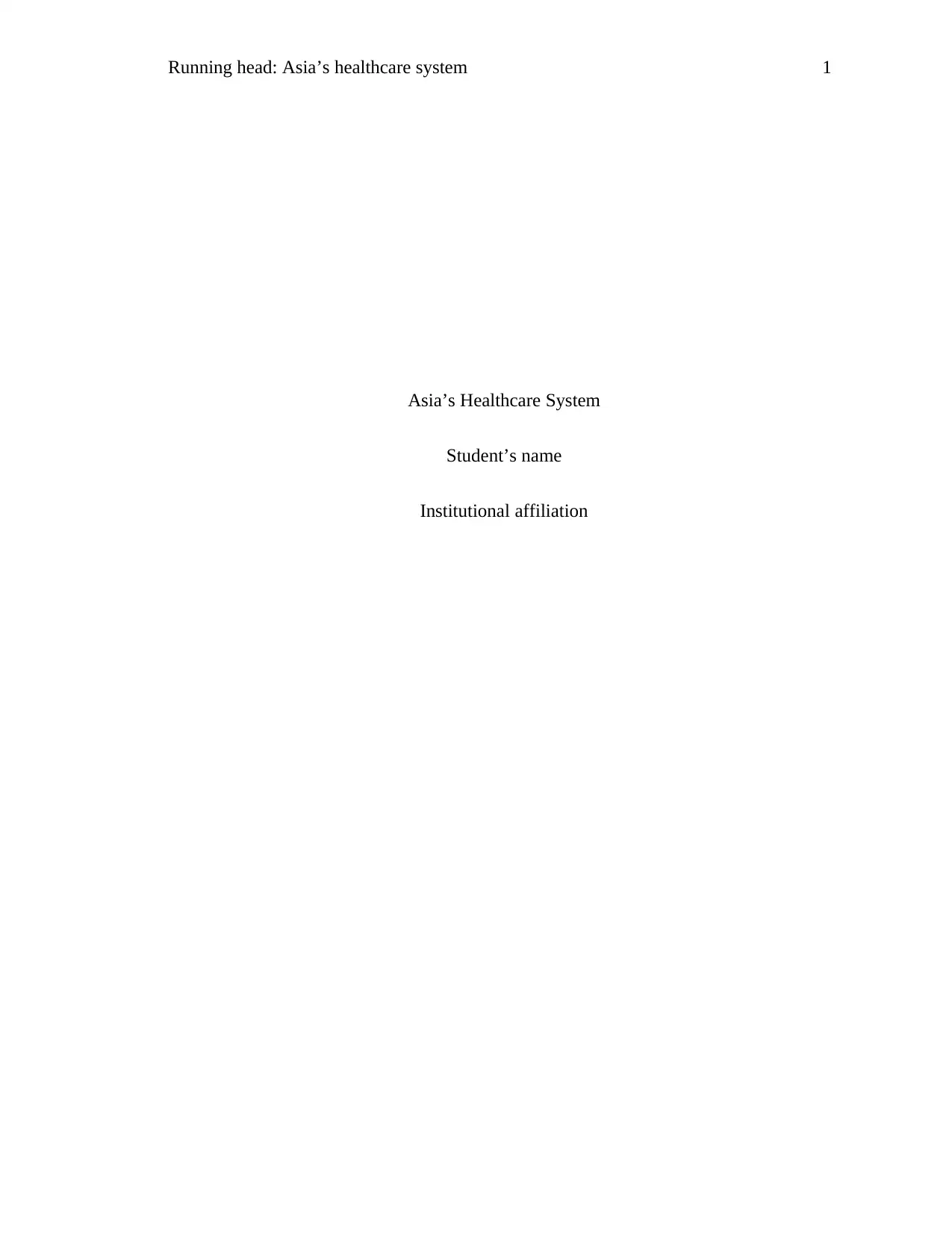
Running head: Asia’s healthcare system 1
Asia’s Healthcare System
Student’s name
Institutional affiliation
Asia’s Healthcare System
Student’s name
Institutional affiliation
Paraphrase This Document
Need a fresh take? Get an instant paraphrase of this document with our AI Paraphraser
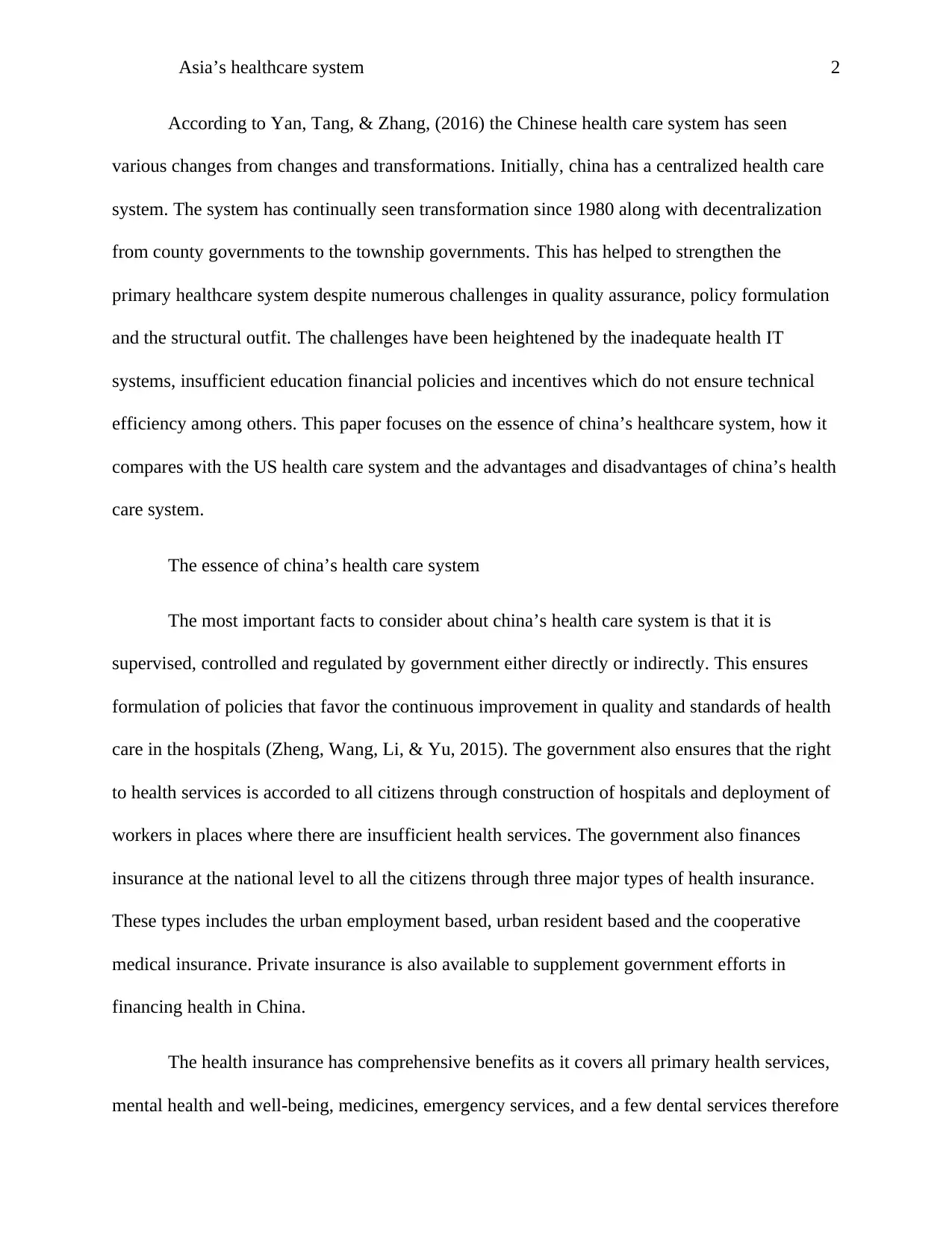
Asia’s healthcare system 2
According to Yan, Tang, & Zhang, (2016) the Chinese health care system has seen
various changes from changes and transformations. Initially, china has a centralized health care
system. The system has continually seen transformation since 1980 along with decentralization
from county governments to the township governments. This has helped to strengthen the
primary healthcare system despite numerous challenges in quality assurance, policy formulation
and the structural outfit. The challenges have been heightened by the inadequate health IT
systems, insufficient education financial policies and incentives which do not ensure technical
efficiency among others. This paper focuses on the essence of china’s healthcare system, how it
compares with the US health care system and the advantages and disadvantages of china’s health
care system.
The essence of china’s health care system
The most important facts to consider about china’s health care system is that it is
supervised, controlled and regulated by government either directly or indirectly. This ensures
formulation of policies that favor the continuous improvement in quality and standards of health
care in the hospitals (Zheng, Wang, Li, & Yu, 2015). The government also ensures that the right
to health services is accorded to all citizens through construction of hospitals and deployment of
workers in places where there are insufficient health services. The government also finances
insurance at the national level to all the citizens through three major types of health insurance.
These types includes the urban employment based, urban resident based and the cooperative
medical insurance. Private insurance is also available to supplement government efforts in
financing health in China.
The health insurance has comprehensive benefits as it covers all primary health services,
mental health and well-being, medicines, emergency services, and a few dental services therefore
According to Yan, Tang, & Zhang, (2016) the Chinese health care system has seen
various changes from changes and transformations. Initially, china has a centralized health care
system. The system has continually seen transformation since 1980 along with decentralization
from county governments to the township governments. This has helped to strengthen the
primary healthcare system despite numerous challenges in quality assurance, policy formulation
and the structural outfit. The challenges have been heightened by the inadequate health IT
systems, insufficient education financial policies and incentives which do not ensure technical
efficiency among others. This paper focuses on the essence of china’s healthcare system, how it
compares with the US health care system and the advantages and disadvantages of china’s health
care system.
The essence of china’s health care system
The most important facts to consider about china’s health care system is that it is
supervised, controlled and regulated by government either directly or indirectly. This ensures
formulation of policies that favor the continuous improvement in quality and standards of health
care in the hospitals (Zheng, Wang, Li, & Yu, 2015). The government also ensures that the right
to health services is accorded to all citizens through construction of hospitals and deployment of
workers in places where there are insufficient health services. The government also finances
insurance at the national level to all the citizens through three major types of health insurance.
These types includes the urban employment based, urban resident based and the cooperative
medical insurance. Private insurance is also available to supplement government efforts in
financing health in China.
The health insurance has comprehensive benefits as it covers all primary health services,
mental health and well-being, medicines, emergency services, and a few dental services therefore
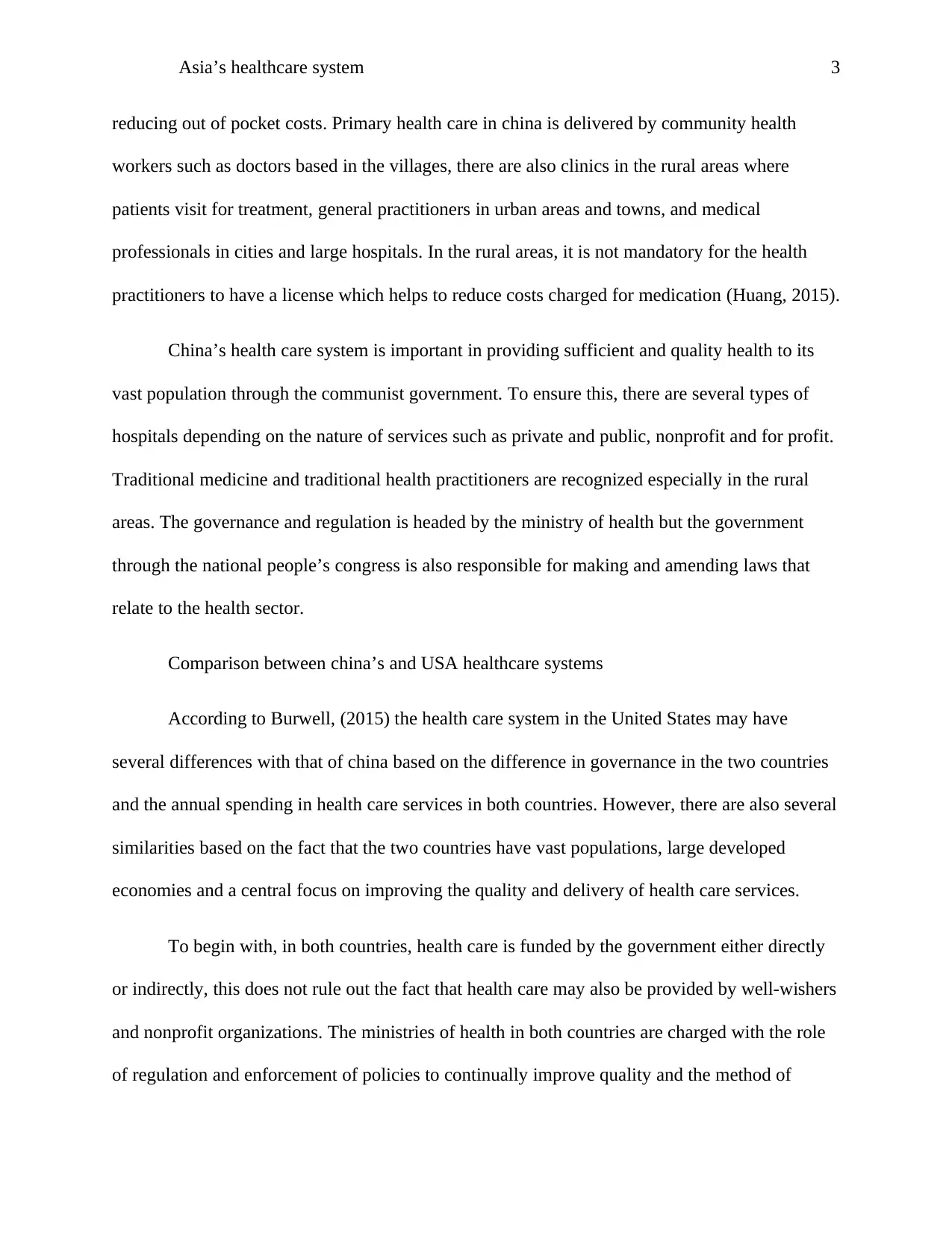
Asia’s healthcare system 3
reducing out of pocket costs. Primary health care in china is delivered by community health
workers such as doctors based in the villages, there are also clinics in the rural areas where
patients visit for treatment, general practitioners in urban areas and towns, and medical
professionals in cities and large hospitals. In the rural areas, it is not mandatory for the health
practitioners to have a license which helps to reduce costs charged for medication (Huang, 2015).
China’s health care system is important in providing sufficient and quality health to its
vast population through the communist government. To ensure this, there are several types of
hospitals depending on the nature of services such as private and public, nonprofit and for profit.
Traditional medicine and traditional health practitioners are recognized especially in the rural
areas. The governance and regulation is headed by the ministry of health but the government
through the national people’s congress is also responsible for making and amending laws that
relate to the health sector.
Comparison between china’s and USA healthcare systems
According to Burwell, (2015) the health care system in the United States may have
several differences with that of china based on the difference in governance in the two countries
and the annual spending in health care services in both countries. However, there are also several
similarities based on the fact that the two countries have vast populations, large developed
economies and a central focus on improving the quality and delivery of health care services.
To begin with, in both countries, health care is funded by the government either directly
or indirectly, this does not rule out the fact that health care may also be provided by well-wishers
and nonprofit organizations. The ministries of health in both countries are charged with the role
of regulation and enforcement of policies to continually improve quality and the method of
reducing out of pocket costs. Primary health care in china is delivered by community health
workers such as doctors based in the villages, there are also clinics in the rural areas where
patients visit for treatment, general practitioners in urban areas and towns, and medical
professionals in cities and large hospitals. In the rural areas, it is not mandatory for the health
practitioners to have a license which helps to reduce costs charged for medication (Huang, 2015).
China’s health care system is important in providing sufficient and quality health to its
vast population through the communist government. To ensure this, there are several types of
hospitals depending on the nature of services such as private and public, nonprofit and for profit.
Traditional medicine and traditional health practitioners are recognized especially in the rural
areas. The governance and regulation is headed by the ministry of health but the government
through the national people’s congress is also responsible for making and amending laws that
relate to the health sector.
Comparison between china’s and USA healthcare systems
According to Burwell, (2015) the health care system in the United States may have
several differences with that of china based on the difference in governance in the two countries
and the annual spending in health care services in both countries. However, there are also several
similarities based on the fact that the two countries have vast populations, large developed
economies and a central focus on improving the quality and delivery of health care services.
To begin with, in both countries, health care is funded by the government either directly
or indirectly, this does not rule out the fact that health care may also be provided by well-wishers
and nonprofit organizations. The ministries of health in both countries are charged with the role
of regulation and enforcement of policies to continually improve quality and the method of
⊘ This is a preview!⊘
Do you want full access?
Subscribe today to unlock all pages.

Trusted by 1+ million students worldwide
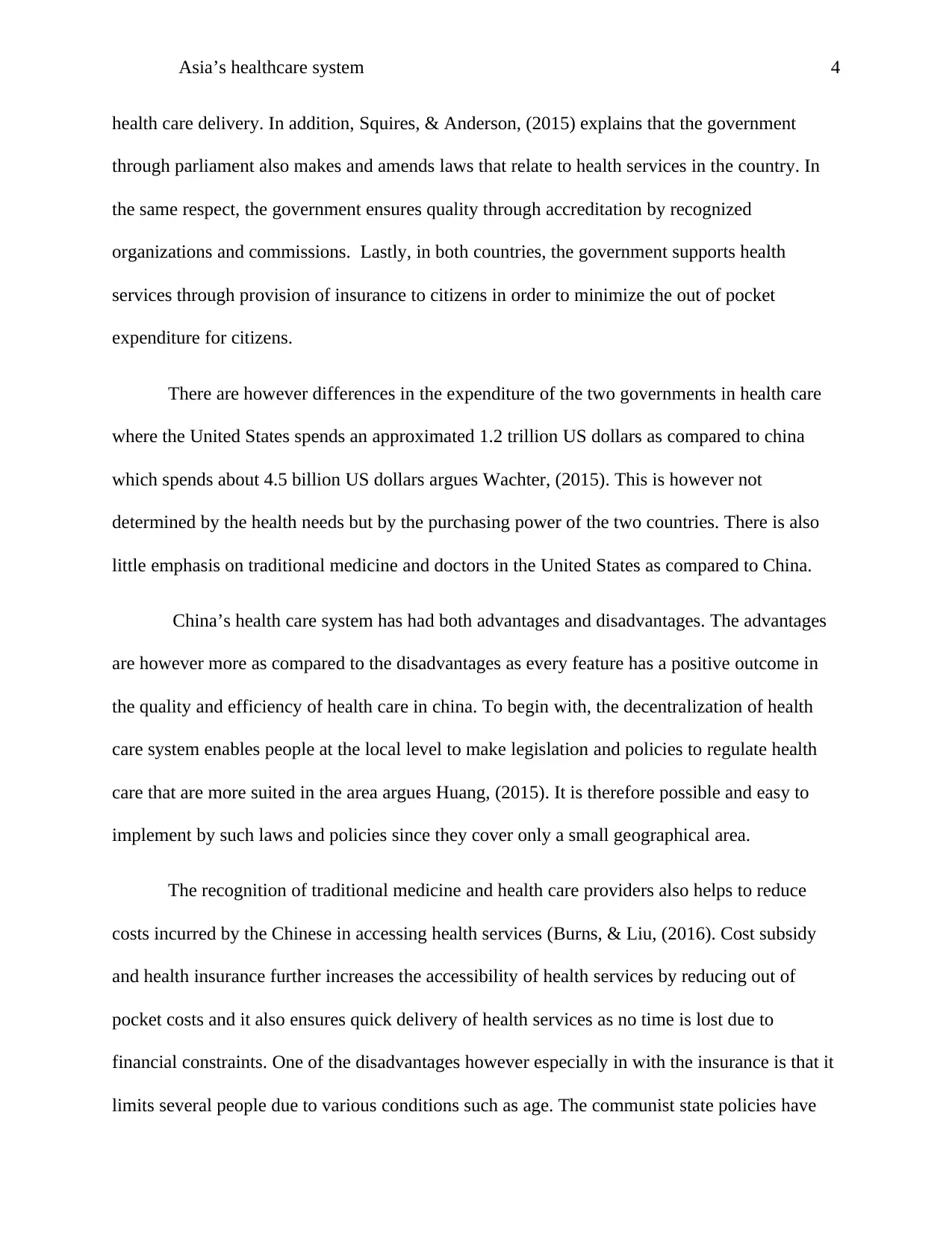
Asia’s healthcare system 4
health care delivery. In addition, Squires, & Anderson, (2015) explains that the government
through parliament also makes and amends laws that relate to health services in the country. In
the same respect, the government ensures quality through accreditation by recognized
organizations and commissions. Lastly, in both countries, the government supports health
services through provision of insurance to citizens in order to minimize the out of pocket
expenditure for citizens.
There are however differences in the expenditure of the two governments in health care
where the United States spends an approximated 1.2 trillion US dollars as compared to china
which spends about 4.5 billion US dollars argues Wachter, (2015). This is however not
determined by the health needs but by the purchasing power of the two countries. There is also
little emphasis on traditional medicine and doctors in the United States as compared to China.
China’s health care system has had both advantages and disadvantages. The advantages
are however more as compared to the disadvantages as every feature has a positive outcome in
the quality and efficiency of health care in china. To begin with, the decentralization of health
care system enables people at the local level to make legislation and policies to regulate health
care that are more suited in the area argues Huang, (2015). It is therefore possible and easy to
implement by such laws and policies since they cover only a small geographical area.
The recognition of traditional medicine and health care providers also helps to reduce
costs incurred by the Chinese in accessing health services (Burns, & Liu, (2016). Cost subsidy
and health insurance further increases the accessibility of health services by reducing out of
pocket costs and it also ensures quick delivery of health services as no time is lost due to
financial constraints. One of the disadvantages however especially in with the insurance is that it
limits several people due to various conditions such as age. The communist state policies have
health care delivery. In addition, Squires, & Anderson, (2015) explains that the government
through parliament also makes and amends laws that relate to health services in the country. In
the same respect, the government ensures quality through accreditation by recognized
organizations and commissions. Lastly, in both countries, the government supports health
services through provision of insurance to citizens in order to minimize the out of pocket
expenditure for citizens.
There are however differences in the expenditure of the two governments in health care
where the United States spends an approximated 1.2 trillion US dollars as compared to china
which spends about 4.5 billion US dollars argues Wachter, (2015). This is however not
determined by the health needs but by the purchasing power of the two countries. There is also
little emphasis on traditional medicine and doctors in the United States as compared to China.
China’s health care system has had both advantages and disadvantages. The advantages
are however more as compared to the disadvantages as every feature has a positive outcome in
the quality and efficiency of health care in china. To begin with, the decentralization of health
care system enables people at the local level to make legislation and policies to regulate health
care that are more suited in the area argues Huang, (2015). It is therefore possible and easy to
implement by such laws and policies since they cover only a small geographical area.
The recognition of traditional medicine and health care providers also helps to reduce
costs incurred by the Chinese in accessing health services (Burns, & Liu, (2016). Cost subsidy
and health insurance further increases the accessibility of health services by reducing out of
pocket costs and it also ensures quick delivery of health services as no time is lost due to
financial constraints. One of the disadvantages however especially in with the insurance is that it
limits several people due to various conditions such as age. The communist state policies have
Paraphrase This Document
Need a fresh take? Get an instant paraphrase of this document with our AI Paraphraser
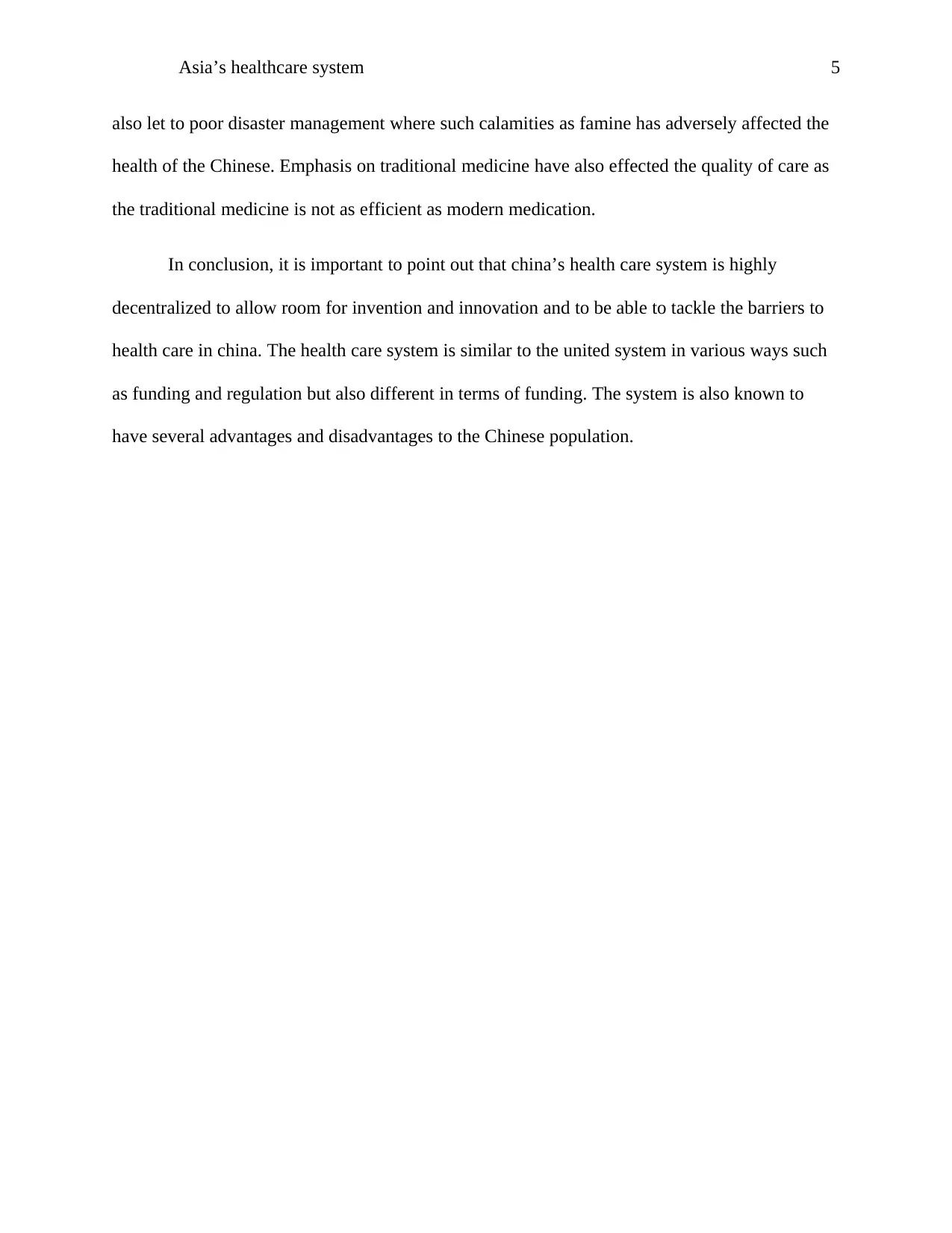
Asia’s healthcare system 5
also let to poor disaster management where such calamities as famine has adversely affected the
health of the Chinese. Emphasis on traditional medicine have also effected the quality of care as
the traditional medicine is not as efficient as modern medication.
In conclusion, it is important to point out that china’s health care system is highly
decentralized to allow room for invention and innovation and to be able to tackle the barriers to
health care in china. The health care system is similar to the united system in various ways such
as funding and regulation but also different in terms of funding. The system is also known to
have several advantages and disadvantages to the Chinese population.
also let to poor disaster management where such calamities as famine has adversely affected the
health of the Chinese. Emphasis on traditional medicine have also effected the quality of care as
the traditional medicine is not as efficient as modern medication.
In conclusion, it is important to point out that china’s health care system is highly
decentralized to allow room for invention and innovation and to be able to tackle the barriers to
health care in china. The health care system is similar to the united system in various ways such
as funding and regulation but also different in terms of funding. The system is also known to
have several advantages and disadvantages to the Chinese population.
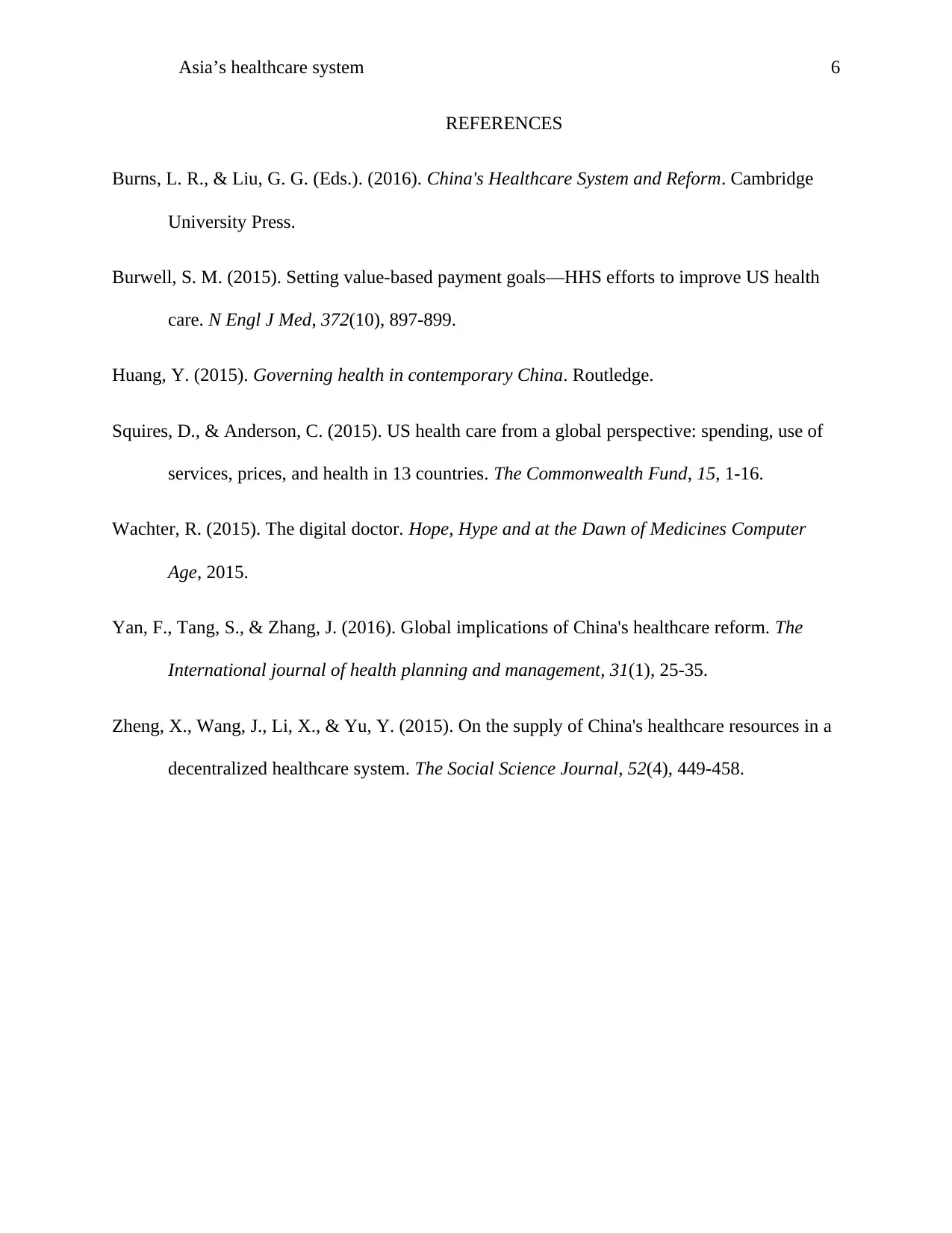
Asia’s healthcare system 6
REFERENCES
Burns, L. R., & Liu, G. G. (Eds.). (2016). China's Healthcare System and Reform. Cambridge
University Press.
Burwell, S. M. (2015). Setting value-based payment goals—HHS efforts to improve US health
care. N Engl J Med, 372(10), 897-899.
Huang, Y. (2015). Governing health in contemporary China. Routledge.
Squires, D., & Anderson, C. (2015). US health care from a global perspective: spending, use of
services, prices, and health in 13 countries. The Commonwealth Fund, 15, 1-16.
Wachter, R. (2015). The digital doctor. Hope, Hype and at the Dawn of Medicines Computer
Age, 2015.
Yan, F., Tang, S., & Zhang, J. (2016). Global implications of China's healthcare reform. The
International journal of health planning and management, 31(1), 25-35.
Zheng, X., Wang, J., Li, X., & Yu, Y. (2015). On the supply of China's healthcare resources in a
decentralized healthcare system. The Social Science Journal, 52(4), 449-458.
REFERENCES
Burns, L. R., & Liu, G. G. (Eds.). (2016). China's Healthcare System and Reform. Cambridge
University Press.
Burwell, S. M. (2015). Setting value-based payment goals—HHS efforts to improve US health
care. N Engl J Med, 372(10), 897-899.
Huang, Y. (2015). Governing health in contemporary China. Routledge.
Squires, D., & Anderson, C. (2015). US health care from a global perspective: spending, use of
services, prices, and health in 13 countries. The Commonwealth Fund, 15, 1-16.
Wachter, R. (2015). The digital doctor. Hope, Hype and at the Dawn of Medicines Computer
Age, 2015.
Yan, F., Tang, S., & Zhang, J. (2016). Global implications of China's healthcare reform. The
International journal of health planning and management, 31(1), 25-35.
Zheng, X., Wang, J., Li, X., & Yu, Y. (2015). On the supply of China's healthcare resources in a
decentralized healthcare system. The Social Science Journal, 52(4), 449-458.
⊘ This is a preview!⊘
Do you want full access?
Subscribe today to unlock all pages.

Trusted by 1+ million students worldwide
1 out of 6
Related Documents
Your All-in-One AI-Powered Toolkit for Academic Success.
+13062052269
info@desklib.com
Available 24*7 on WhatsApp / Email
![[object Object]](/_next/static/media/star-bottom.7253800d.svg)
Unlock your academic potential
Copyright © 2020–2025 A2Z Services. All Rights Reserved. Developed and managed by ZUCOL.




